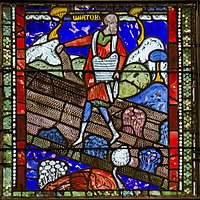
Photo from wikipedia
Abstract Rehydroxylation dating trials were conducted on post-medieval ceramics (bricks) of known age, testing a new component based approach. Age estimates were produced using both a t1/4 and a more… Click to show full abstract
Abstract Rehydroxylation dating trials were conducted on post-medieval ceramics (bricks) of known age, testing a new component based approach. Age estimates were produced using both a t1/4 and a more generalized t1/n model for describing the Stage 2 mass gain, the latter providing a more satisfactory description of the mass gain curves. Despite this, the estimated ages are generally too old for agreement with known ages; the magnitude of the discrepancies suggests issues beyond the particular models used. The effect of uncertainties associated with the effective lifetime temperature (ELT) of the ceramic were explored, aided by the generation of age-temperature curves; while potentially a strong contributor, the large age discrepancies can not be explained by ELT issues. The mass of organic matter removed during reheating (estimated from the organic carbon content) is more problematic, suffering from considerable uncertainties on account of a poorly defined organic matter to organic carbon (OM/OC) ratio of 1.4–2.5; again, the large age estimates can not be explained by this factor alone. Additional factors, including incomplete drying, mineral alteration, and short term elevated temperature events (STETEs), are outlined as potential contributors to age discrepancies and uncertainties, further complicating assessment of the results and method. Because of this, the results are considered inconclusive with respect to evaluating in full the effectiveness of the component based approach. However, these results highlight a range of practical difficulties and problematic effects that must be eliminated or minimized in future RHX dating trials; suggestions are made in this regard.
Journal Title: Journal of Archaeological Science: Reports
Year Published: 2017
Link to full text (if available)
Share on Social Media: Sign Up to like & get
recommendations!